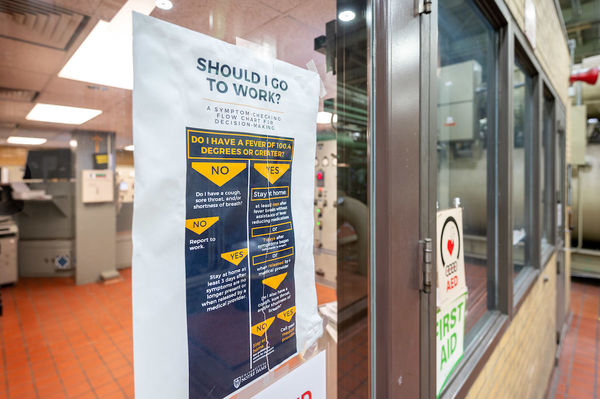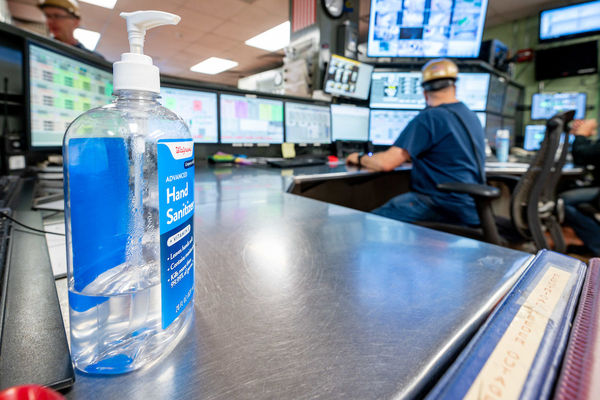

response to the COVID-19 outbreak. Employees have access to hand sanitizer and disinfectant
wipes, and signage serves as a reminder to be aware of and react appropriately to any symptoms.
(Photos by Matt Cashore/University of Notre Dame)
As part of the University’s response to the coronavirus pandemic, it’s anything but business as usual at the Power Plant. To protect the health of the vital few experts who know how to operate the facility that provides electricity, heating, cooling, hot and cold water and emergency power to campus, Utilities directors have been taking extra precautions.
Since mid-March, the Power Plant has only been open to plant personnel, with the exception of critical repair contractors. On a daily basis, when staff members enter the building at the beginning of their shifts, they use hand sanitizer and disinfecting wipes and take their body temperature before getting to work. “I don’t think we’ve ever wiped our door handles as much as we have the last four weeks,” says Joe Herman, power plant manager. “I’m doing everything I can to protect those people.”
Herman and other Utilities directors have thought carefully about how to limit exposure to operators. In addition to having disinfecting sprays and wipes strategically located throughout the building, they stagger the start and stop times of staff and ensure that they are apart from each other at shift change. The teams are separated from each other and communicate via telephone, radio and Zoom. Each team has taken on the responsibility of cleaning their restrooms, sweeping and emptying trash. “We can’t afford for the virus to affect our staff,” he explains.
For a department that continually stresses the value of communication and teamwork, this time has been particularly challenging. “We encourage and teach everyone to communicate effectively with each other to build strong relationships and now must enforce social separation,” he says. “You begin to miss the non-verbal communication.” In times like these, one realizes how much information gestures and facial expressions convey. So, when they need to talk in person, the operators keep their distance and talk from six to eight feet away from each other.
As many of the University’s 200 buildings remain nearly vacant during the shelter-in-place directives from the state, the Utilities’ Building Controls group is able to reduce the University’s energy consumption of some of those unoccupied buildings by reducing the operating hours of equipment and adjusting the temperature range.

“With such a dramatic decrease in occupancy, our goal is to maintain utilities to facilities where essential operations and research are underway, but limit the consumption of energy to the greatest degree possible without adding risk of property loss,” says Mark Hummel, assistant director of Utilities.
To that end, the normal operating schedule for HVAC (heating, ventilating, air conditioning) systems have been scaled back to match the usage in each building. Research buildings, such as McCourtney Hall, Stinson-Remick Hall and Stepan Chemistry continue to operate normally, 24 hours a day, seven days a week, while classroom and academic facilities operate at normal temperature ranges only between 8 a.m. to 5 p.m. during the week to support online instruction. Because residence halls are partially occupied by rectors and other hall staff, the HVAC systems serve the occupied spaces as usual, while expanding the temperature limits in the student rooms to conserve energy. Some administrative facilities, such as the Main Building, continue to operate normally.
“Utilities is one of a number of areas within the Facilities Design and Operations Division that is essential to campus’ operation even in this hibernated state,” says Paul Kempf, assistant vice president for utilities and maintenance. “We are also very pleased and appreciative of the dedication and commitment to the institution by all our staff including Maintenance, Landscape Services, Planning Design and Construction and University Facilities Information whether working here on the job, working remotely or standing ready to help whenever and wherever needed.”Outside of scheduled hours, the systems conserve energy as they normally do throughout the year by expanding the allowable temperature limits to 60 degrees F for heating and 85 degrees F for cooling. While it is too early to tell what the energy savings will be, Hummel says, “We’ve seen a significant reduction in the demand for energy simply because much of campus is unoccupied.”